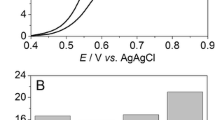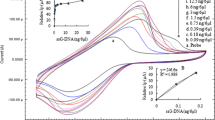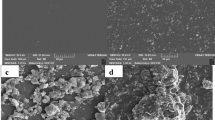Abstract
Carbon/1-octadecanethiol-carboxylated multiwalled carbon nanotubes (cMWCNT) composite was used to construct a DNA sensor for detection of human bacterial meningitis caused by Neisseria meningitidis. The carbon composite electrode was used to covalently immobilize 5′-amine-labeled 19-mer single-stranded DNA (ssDNA) probe, which was hybridized with 1.35 × 102–3.44 × 104 pM (0.5–128 ng/5 μl) of single-stranded genomic DNA (ssG-DNA) of N. meningitidis for 10 min at room temperature (RT). The surface topography of the DNA sensor was characterized by using scanning electron microscopy (SEM) and Fourier transform infrared spectroscopy (FTIR) while electrochemically characterized by electrochemical impedance. The immobilization of ssDNA probe and hybridization with ssG-DNA were detected electrochemically by cyclic voltammetry (CV) and differential pulse voltammetry (DPV) at RT in 30 min with a response time of 1 min. The DNA sensor showed high pathogenic specificity and can distinguish among complement, noncomplement, one base mismatch, and triple base mismatch oligomer targets. The limit of detection (LOD) and sensitivity of the sensor were approximately 68 pM and 38.095 (μA/cm2)/nM of ssG-DNA, respectively, using DPV. The improved sensitivity and LOD of the sensor can be attributed to the higher efficiency of probe immobilization due to high surface area-to-volume ratio and good electrical activity of cMWCNT.

ᅟ






Similar content being viewed by others
References
Dash SK, Sharma M, Kumar A (2012) In: Houllis G, Karachalios M (eds) Meningitis: Causes, diagnosis and treatment, 1st edn. Nova Science Publishers, New York
Brouwer MC, Tunkel AR, van de Beek D (2010) Epidemiology, diagnosis, and antimicrobial treatment of acute bacterial meningitis. Clin Microbiol Rev 23:467–492
Chanteau S, Dartevelle S, Mahamane AE, Djibo S, Boisier P, Nato F (2006) New rapid diagnostic tests for Neisseria meningitidis serogroups A, W135, C, and Y. PLoS Med 3:1579–1586
Wu HM, Cordeiro SM, Harcourt BH, Carvalho M, Azevedo J, Oliveira TQ et al (2013) Accuracy of real-time PCR, Gram stain and culture for Streptococcus pneumoniae, Neisseria meningitidis and Haemophilus influenzae meningitis diagnosis. BMC Infect Dis 13:26. doi:10.1186/1471-2334-13-26
Dash SK, Sharma M, Khare S, Kumar A (2012) rmpM gene as a genetic marker for human bacterial meningitis. Cell Mol Biol 58(1):26–30
Dash SK, Sharma M, Khare S, Kumar A (2013) Quick diagnosis of human brain meningitis using Omp85 gene ampilicon as a genetic marker. Indian J Microbiol 53:238–240
Wang X, Theodore MJ, Mair R, Trujillo-Lopez E, du Plessis M, Wolter N et al (2012) Clinical validation of multiplex real-time PCR assays for detection of bacterial meningitis pathogens. J Clin Microbiol 50:702–708
Patnaik S, Dash SK, Sethi D, Kumar A, Gupta KC, Kumar P (2012) Engineered polymer-supported synthesis of 3′-carboxyalkyl-modified oligonucleotides and their applications in the construction of biochips for diagnosis of the diseases. Bioconjug Chem 23:664–670
Ferraz AS, Belo EF, Coutinho LM, Oliveira AP, Carmo AM, Franco DL et al (2008) Storage and stability of IgG and IgM monoclonal antibodies dried on filter paper and utility in Neisseria meningitidis serotyping by dot–blot ELISA. BMC Infect Dis 8:30. doi:10.1186/1471-2334-8-30
Siddiquee S, Yusof NA, Salleh AB, Tan SG, Bakar FA (2012) Development of electrochemical DNA biosensor for Trichoderma harzianum based on ionic liquid/ZnO nanoparticles/chitosan/gold electrode. J Solid State Electrochem 16:273–282
Wang Y, Liu H, Wang F, Gao Y (2012) Electrochemical oxidation behavior of methotrexate at DNA/SWCNT/Nafion composite film-modified glassy carbon electrode. J Solid State Electrochem 16:3227–3235
Sun Q, Zhang S (2012) Electrochemiluminescence DNA sensor based on Ru(bpy)3 2+-doped silica nanoparticle labeling and proximity-dependent surface hybridization assay. J Solid State Electrochem 16:247–252
Fourati N, Lazerges M, Vedrine C, Fougnion J-M, Zerrouki C, Rousseau L et al (2009) Surface acoustic waves sensor for DNA biosensor development. Sens Lett 7:1–4
Patel MK, Solanki PR, Seth S, Gupta S, Khare S, Kumar A, Malhotra BD (2009) CtrA gene based electrochemical DNA sensor for detection of meningitis. Electrochem Commun 11:969–973
Patel MK, Solanki PR, Kumar A, Khare S, Gupta S, Malhotra BD (2010) Electrochemical DNA sensor for Neisseria meningitidis detection. Biosens Bioelectron 25:2586–2591
Dash SK, Sharma M, Khare S, Kumar A (2013) Omp85 DNA sensor for detection of human brain bacterial meningitis. Biotechnol Lett 35:929–935
Dash SK, Sharma M, Khare S, Kumar A (2013) rmpM DNA sensor for detection of human brain bacterial meningitis in cerebrospinal fluid. Appl Biochem Biotechnol 171:198–208
Du M, Yang T, Jiao K (2010) Carbon nanotubes/(pLys/dsDNA) n layer-by-layer multilayer films for electrochemical studies of DNA damage. J Solid State Electrochem 14:2261–2266
Dash SK, Sharma M, Khare S, Kumar A (2014) Carbon-mercaptooctadecane/carboxylated multi-walled carbon nanotubes composite based genosensor for detection of bacterial meningitis. Indian J Microbiol 54:170–177
Wang F, Xu Y, Wang L, Lu K, Ye B (2011) Immobilization of DNA on a glassy carbon electrode based on Langmuir–Blodgett technique: application to the detection of epinephrine. J Solid State Electrochem 16:2127–2133
Pandey CM, Singh R, Sumana G, Pandey MK, Malhotra BD (2011) Electrochemical DNA sensor based on modified octadecanethiol self-assembled monolayer for Escherichia coli detection. Sensors Actuators B 151:333–340
Mori Y, Seki M (2007) Synthesis of multi-functionalized ketones through the fukuyama coupling reaction catalyzed by Pearlman’s catalyst: preparation of ethyl 6-oxotridecanoate. Org Synth 84:285–294
Kumar A, Dash SK, Sharma DP (2012) In: Singh HP, Chowdappa P, Chakroborty BN, Podie AR (eds) Plant fungal disease management. Delhi, Westville Publishers
Herrasti Z, Etxabe I, Mitxelena JM, Martienz MP, Martienz F (2012) Development and integration of an electrochemical system in a LOC device for DNA detection. Procedia Eng 47:25–28
Fitzpatrick DA, Creevey CJ, McInerney JO (2005) Evidence of Darwinian selection in putative meningococcal vaccine antigens. J Mol Evol 61:90–98
Voulhoux R, Bos MP, Geurtsen J, Mols M, Tommasen J (2003) Role of a highly conserved bacterial protein in outer membrane protein assembly. Science 299:262–265
Lamas-Ardisanaa PJ, Queipob P, Fanjul-Boladoa P, Costa-García A (2008) Multiwalled carbon nanotube modified screen-printed electrodes for the detection of p-aminophenol: optimisation and application in alkaline phosphatase-based assays. Anal Chim Acta 615:30–38
Park SH, Jin SH, Jun GH, Jeon S, Hong SH (2011) Enhanced electrical properties in carbon nanotube/poly(3-hexylthiophene) nanocomposites formed through non-covalent functionalization. Nano Res 4:1129–1135
Rahman MM, Shiddiky MJ, Rahman MA, Shim YB (2009) A lactate biosensor based on lactate dehydrogenase/nictotinamide adenine dinucleotide (oxidized form) immobilized on a conducting polymer/multiwall carbon nanotube composite film. Anal Biochem 384:159–165
Zhang J, Lang HP, Yoshikawa G, Gerber C (2012) Optimization of DNA hybridization efficiency by pH-driven nanomechanical bending. Langmuir 28:6494–6501
Li L, Lin R, He H, Jiang L, Gao M (2013) Interaction of carboxylated single-walled carbon nanotubes with bovine serum albumin. Spectrochim Acta A Mol Biomol Spectrosc 105:45–51
Lata S, Batra B, Singala N, Pundir CS (2013) Construction of amperometric l-amino acid biosensor based on l-amino acid oxidase immobilized onto ZnONPs/c-MWCNT/PANI/AuE. Sensors Actuators B 188:1080–1088
Tang H, Chen J, Cui K, Nie L, Kuang Y, Yao S (2006) Immobilization and electrooxidation of calf thymus deoxyribonucleic acid at alkylamine modified carbon nanotube electrode and its interaction with promethazine hydrochloride. J Electroanal Chem 587:269–275
Tam PD, Hieu NV, Chien ND, Le A-T, Tuan MA (2009) DNA sensor development based on multi-wall carbon nanotubes for label-free influenza virus (type A) detection. J Immunol Methods 350:118–124
Kim W-S, Kima HS, Park I-S, Kim Y, Chung K, Lee JK, Sung Y-E (2007) Electrochemical performance of nano-Pt-supported carbon anode for lithium ion batteries. Electrochim Acta 52:4566–4571
Kobayashi K, Kitagawa S, Ohtani H (2006) Development of capillary column packed with thiol-modified gold-coated polystyrene particles and its selectivity for aromatic compounds. J Chromatogr A 1110:95–101
Zhenzhen Z, Qishu Q, Xinxin Z, Xue G, Yan W, Chao Y (2009) Preparation and evaluation of octadecanethiol modified gold microspheres in capillary liquid chromatography and pressurized capillary electrochromatography as stationary phase. Chin J Chromatogr 27:431–435
Zhang W, Zhong P, Zheng X, Wang L (2010) An enhanced sensing platform for ultrasensitive impedimetric detection of target genes based on ordered FePt nanoparticles decorated carbonnanotubes. Biosens Bioelectron 42:481–485
Panicker RM, Priya S (2014) Fabrication of flexible conducting thin films of copper-MWCNT from multi-component aqueous suspension by electrodeposition. J Solid State Electrochem 18:487–496
Liu R, Sha M, Jiang S, Luo J, Liu X (2014) A facile approach for imprinting protein on the surface of multi-walled carbon nanotubes. Talanta 120:76–83
Liu C-C, Sadhasivam S, Savitha S, Lin F-H (2014) Fabrication of multiwalled carbon nanotubes–magnetite nanocomposite as an effective ultra-sensing platform for the early screening of nasopharyngeal carcinoma by luminescence immunoassay. Talanta 122:195–200. doi:10.1016/j.talanta.2014.01.055
Bonanni A, Pividori MI, del Valle M (2007) Application of the avidin–biotin interaction to immobilize DNA in the development of electrochemical impedance DNA sensors. Anal Bioanal Chem 389:851–861
Lisdat F, Schafer D (2008) The use of electrochemical impedance spectroscopy for biosensing. Anal Bioanal Chem 391:1555–1567
Liu X, Luo L, Ding Y, Kang Z, Ye D (2012) Simultaneous determination of l-cysteine and l-tyrosine using Au-nanoparticles/poly-eriochrome black T film modified glassy carbon electrode. Bioelectrochemistry 86:38–45
Shahryari Z, Goharrizi AS, Azadi M (2010) Experimental study of methylene blue adsorption from aqueous solutions onto carbon nanotubes. Int J Water Res Environ Eng 2:016–028
Nicholson MM (1954) Diffusion currents at cylindrical electrodes: a study of organic sulphides. J Am Chem Soc 76:2539–2545
Bond M (2003) Broadening electrochemical horizons: Principles and illustration of voltammetric and related techniques. UK
Zanello P (2003) Inorganic electrochemistry: Theory practice and applications. UK
Jindal K, Tomar M, Gupta V (2012) CuO thin film based uric acid biosensor with enhanced response characteristics. Biosens Bioelectron 38:11–18
Yoon S-I, Lim M-H, Park S-C, Shin J-S, Kim Y-J (2008) Neisseria meningitidis detection based on a microcalorimetric biosensor with a split-flow microchannel. J Microelectromech Syst 7:590–598
Tak M, Gupta V, Tomar M (2014) Flower-like ZnO nanostructure based electrochemical DNA biosensor for bacterial meningitis detection. Biosens Bioelectron 59:200–207
Loaiza OA, Campuzano S, Pedrero M, Pingarrón JM (2007) DNA sensor based on an Escherichia coli lac Z gene probe immobilization at self-assembled monolayers-modified gold electrodes. Talanta 73:838–844
Acknowledgment
S.K. Dash thanks University Grant Commission for providing senior research fellowship.
Author information
Authors and Affiliations
Corresponding author
Electronic supplementary material
Below is the link to the electronic supplementary material.
Fig. S1
UV spectra of MWCNT at 190-320 nm A after sonication in H2SO4:HNO3 (3:1, v/v) for 0, 4, 6, 8, 10, and 12 h (a-f), B after sonication in autoclaved ddH2O for 0, 4, 6, 8, and 12 h (a-e) (PDF 81 kb)
Fig. S2
A Cyclic voltammogram of carbon (a) and carbon/ODT-cMWCNT composite (b), B Differential pulse voltammogram of carbon (a) and carbon/ODT-cMWCNT composite (b) (PDF 158 kb)
Fig. S3
Cyclic voltammogram of carbon/ODT-MWCNT/ssDNA (a), after hybridization with 4.3x103 pM of ssG-DNA of N. meningitidis for 2, 5, 10, 15, and 20 min (b-f) (PDF 166 kb)
Fig. S4
A Plot between CV relative I pc with respect to carbon/ODT-MWCNT/ssDNA and different concentrations of hybridizing ssG-DNA (0.0-3.44 × 104 pM) from Fig. 4B inset, inset shows 0.0-5.40 × 102 pM region of the plot for calculation of the slope, sensitivity, and LOD of the sensor using CV. B Plot between DPV relative I p with respect to carbon/ODT-MWCNT/ssDNA and different concentrations of hybridizing ssG-DNA (0.0-3.44 × 104 pM) from Fig. 5A inset, inset shows 0.0-5.40 × 102 pM region of the plot for calculation of slope, sensitivity, and LOD of the sensor using DPV (PDF 218 kb)
Fig. S5
Plot between % I p (DPV) of carbon/ODT-MWCNT/ssDNA and time measured over a period of 180 days at intervals of 15 days, the values shown are averages of three readings taken at same conditions (PDF 112 kb)
Rights and permissions
About this article
Cite this article
Dash, S.K., Sharma, M., Kumar, A. et al. Carbon composite-based DNA sensor for detection of bacterial meningitis caused by Neisseria meningitidis . J Solid State Electrochem 18, 2647–2659 (2014). https://doi.org/10.1007/s10008-014-2525-9
Received:
Revised:
Accepted:
Published:
Issue Date:
DOI: https://doi.org/10.1007/s10008-014-2525-9




